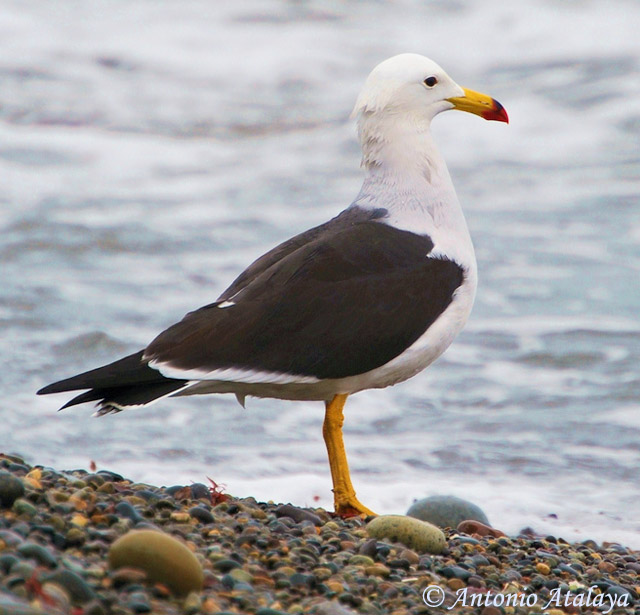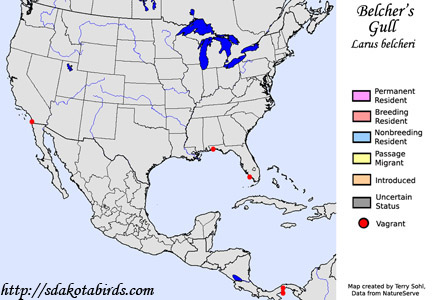| Length: 20 inches | Wingspan: 48 inches | Seasonality: Non-resident in South Dakota |
| ID Keys: Very dark mantle, white underparts, head, and neck, long yellow bill with black and red at tip. Black band on end of white tail. In non-breeding plumage, birds get a darker-colored "hood". | ||
 The
Belcher's Gull was previously known as the "Band-tailed Gull", along with
what is now called the Olrog's Gull, a species found on the Atlantic Coast
of South America. The Belcher's Gull is found in Peru and Chile on the
Pacific coast of South America. The two species were once called the
"Band-tailed Gull" due to the obvious dark band on the end of its white
tail. It is named for the British explorer Sir Edward Belcher.
In North America, they are known from just a handful of sightings, with one
sighting near San Diego in 1987, and a few sightings in Florida. Note
that the sightings in Florida of "Band-tailed Gulls" could be Olrog's Gull,
given the range of that species on the Atlantic Ocean.
The
Belcher's Gull was previously known as the "Band-tailed Gull", along with
what is now called the Olrog's Gull, a species found on the Atlantic Coast
of South America. The Belcher's Gull is found in Peru and Chile on the
Pacific coast of South America. The two species were once called the
"Band-tailed Gull" due to the obvious dark band on the end of its white
tail. It is named for the British explorer Sir Edward Belcher.
In North America, they are known from just a handful of sightings, with one
sighting near San Diego in 1987, and a few sightings in Florida. Note
that the sightings in Florida of "Band-tailed Gulls" could be Olrog's Gull,
given the range of that species on the Atlantic Ocean.
Habitat: Found around both rocky or sandy coastlines. They are primarily found in coastal areas with shallow waters.
Diet: Omnivorous. Food items may include fish, crustaceans, mollusks, eggs, small birds and fledglings, rodents, amphibians, insects, and carrion and refuse.
Behavior: Uses a variety of foraging techniques, depending upon food item being pursued. They will often walk on the shoreline or in shallow water in search of food. They also will swim on the ocean's surface and grab food. They often will attempt to steal food from other gull and bird species, harassing them until flight until the other bird drops or disgorges their catch.
Nesting: A colonial nester, nesting on nearshore islands. The nest of Belcher's Gull is a depression on the ground, lined with moss, grasses, leaves, or other vegetative material. The nest is placed in crevices in rocky areas, or on sandy beaches near the high-tide line. The female usually lays 3 eggs, and both parents help to incubate them.
Interactive eBird Map: Click to access an interactive eBird map of Belcher's Gull sightings
Song: No information
Migration: Considered a permanent resident on coastal Peru and Chile, with occasional wandering as far north as Panama.
Similar Species: Most similar to the Black-tailed Gull or Kelp Gull (like the Belcher's Gull, neither species is normally found in North America). Was once considered the same species as the Olrog's Gull of South America.
Conservation Status: Populations are small, but they appear to be increasing. The IUCN lists the Belcher's Gull as a species of "Least Concern".
Further Information: 1) Cornell's Neotropical Birds - Belcher's Gull
2) BirdLife International - Larus belcheri
3) Band-tailed Gull photographed in Florida
Photo Information: Photo taken by Antonio Atalaya - September 6th, 2008 - La Punta, Lima, Peru - Photo licensed under Creative Commons Attribution NonCommercial NoDerivs 2.0 Generic License.
| Click below for a higher-resolution map |
 |
| South Dakota Status: Non-resident in South Dakota |
Additional Belcher's Gull Photos (coming soon!!)
